8 (Pointless) Laws All Comic Book Movies Follow

Hollywood is a land of money and cowardice. Every big film is basically a $150 million gamble, so they tend to play it safe and stick to a successful formula.
Nowhere is this more evident than in the genre of big-budget superhero franchises, where it's been decided that you must follow most if not all of the eight rules below:
The First Film Requires a Tedious Origin Story

For some unknown reason, tradition states that the first movie must consist largely of something no one in the audience paid to see: The superhero as he lived before he could do any cool superhero stuff.
Other genres don't feel the need to do this; Die Hard didn't spend the first half of the movie with John McClane taking target practice, Rambo didn't spend an hour showing Rambo in basic training. Why can't we just jump in?
Instead we have to watch Peter Parker struggling as a photographer, and Bruce Banner quietly working as a scientist, as if we must first appreciate the tedium of their regular lives before we get to see them jump off an exploding building.
And to double the problem, they usually throw in an origin story for one or more of the villains, too. Behold! Here is the awesome badass supervillain, back when he was just a disgruntled dude in a lab coat!

Often to save time they'll cram those two origin stories together, by having the main villain kill off the hero's parents (regardless of whether or not it happened in the comic book) simultaneously starting their respective careers in superheroism and supervillainy.

A young Joker kills Bruce Wayne's parents, Robin's are trapezed to death, Kingpin kills Daredevil's dad
Also ...
In Spider-Man 3, the previous origin story is changed so that the current villain (The Sandman, Marko Cain) is now the murderer of Uncle Ben, a plot point based entirely on the premise that none of the fans owned a DVD of the first film.
The Sequels Must Have Multiple Villains

For the first film, the franchise always whips out the most prominent villain in the hero's rogue gallery. They don't have a choice, millions are at stake and if you go with a lesser villain there may not be any sequels at all. Unfortunately, this means that you're going with a decreasing grade of villain for the rest of the series.
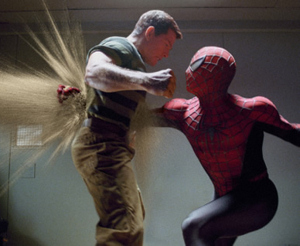
He's made of sand
Thus introduces the Multiple B-List Villain Rule: Since the best villain has been used in the first film, all sequels must use a minimum of two less-popular villains. Quantity to make up for quality. Michael Keaton's Batman fought the Joker first, then found himself simultaneously taking on the combination of the Penguin and Christopher Walken. Superman fights Lex Luthor in the first film, in the second he's going up against Lex and three supervillains.
They do sometimes cheat this rule by trying to bring back the first villain as often as possible, regardless of whether the villain died in the first movie. They'll film flashbacks if necessary. Lex Luthor, Magneto, Dr. Doom and the Green Goblin have all appeared in nearly every single film in their respective franchises--two of them returning from on-screen deaths, proving that nothing is impossible in a world where big box office dollars are at stake.
Also ...
Interestingly (or bafflingly, depending on your point of view) the villains often turn up in a predictable pattern: the Brain, the Bod and the Bumbler.
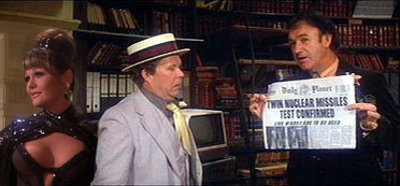
Ms. Teschmacher (the Bod) Otis (the Bumbler) Lex (the Brains)
The Brain is the planner and nearly always creates the main conflict the heroes must resolve. However, since the plan is usually very simplistic and takes about two seconds of screen time to explain, the Brain spends most of their screen time heaping verbal or even physical abuse on the Bumbler.

Bod -> Brains -> Bumbler
The Bod is usually there to show cleavage, wear tight leather pants and show partial nudity. Some market research suggests this appeals to comic book fans.

The Bumbler began as just that, a character who shuffles around, usually screwing up the simplest of assignments. However, this role has evolved into a mute or retarded character with great physical strength but little in the way of brains. However, they are still the target of jokes and abuse by other characters. Plus, they often provide many of the film's comic relief which may or may not be gut-wrenchingly awful.
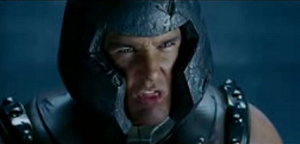
No one knows why this formula has been used so often. Perhaps it is some sort of primal urge in humanity where the three faces represent the three ages of man. Or, perhaps there's some deep psychological comfort in triangles or groups of three. Maybe it's a subconscious representation of the Holy Trinity or a subliminal image of the Masonic Pyramid.
Or, maybe Hollywood executives think we're fucking imbeciles.

You get the idea.
In Part 2, the Hero Must Reveal His Identity to Someone
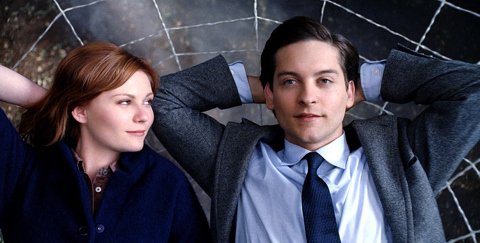
Look, Hollywood, the whole "secret identity" thing is there for a reason. In the comic, a hero's secret identity is the only way they prevent their enemies from sending wave after wave of henchmen after them and their families and friends. Yet, in the transition to film, secret identities are often the first casualty.
Secret identities are usually revealed in the second film in the franchise, to a girlfriend, family member or even the villain. For instance in Superman II, a Superman who is desperate to get into Margot Kidder's pants reveals his secret identity, undergoes possibly permanent genetic damage by using radiation to get rid of his powers, walks from the North Pole to Alaska, and gets a good beating along the way. Hope she was worth it, dude.
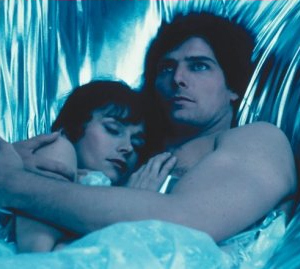
Michael Keaton, also in an effort to get into somebody's pants, reveals his secret identity in Batman Returns to his girlfriend and the Penguin, also revealing a previously unknown fact about Batman: his mask is made out of Fruit Roll-Ups.

Though neither of them can even come close to touching Peter Parker in Spider-Man 2, who reveals his identity to:
a) Harry Osbourne
b) Mary Jane Watson
c) Dr. Octopus
d) A subway train full of passengers
It was almost like that last season of Ellen where every episode was about her telling some new group of strangers that she's a lesbian. But remember: THAT WAS THE LAST SEASON OF ELLEN.

Also ...
There is with this rule the Doomed Franchise Corollary: If the film is not likely to have a sequel (Daredevil) and/or incredibly stupid (Daredevil) then what the hell, go ahead and reveal the secret identity to someone in the first film.
Part 3 Must Feature an Evil Version of the Hero

Hollywood hates boy scouts, so nearly all heroes have to turn evil, at least temporarily. Nearly always, this change occurs in the third film of the series. Usually the hero somehow has to fight the evil version of himself, demonstrating with some of the most ham-fisted symbolism possible that the real villain is within ourselves. Get it?!
Most of us are still having nightmares about Spider-Man 3, where Peter Parker, under the control of the alien symbiote, turned into the love child of Alex from A Clockwork Orange and John Travolta from Saturday Night Fever, while looking oddly like a lesbian biker.

The evil symbiote then bonds with Eddie Brock to become Venom, the evil version of Spider-Man, and they fight to the death.
Only slightly less ridiculous was Superman 3. Unable to figure out the "secret ingredient" for kryptonite, Gus Gorman substitutes cigarette tar into the formula, which causes Superman to turn into an alcohol-fueled sex machine. This then causes Superman to split into a Good and Bad Superman, which then, you guessed it, fight each other to the death.
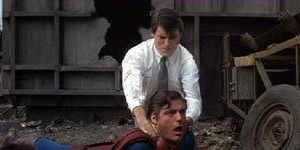
Also ...
They found another way to handle this in X-Men 2, since they have a group of heroes, they were able to mix it up a little bit by just having some of the heroes turn on each other.
Thus Phoenix must fight a brainwashed Cyclops, a brainwashed Professor X almost kills everybody, a brainwashed Nightcrawler almost kills the President and Wolverine must fight a brainwashed Lady Deathstryke. As an added bonus, Lady Deathstryke is the evil twin of Wolverine, but less hairy and almost as hot.
Another variation occurs in Batman & Robin, where a mind-controlled Batman and Robin, apparently under the hypnotic control of Poison Ivy, argue about who gets to pork her.
The Hero Must Lose His Powers at Some Point

Oh, clever Hollywood! In order to make the hero's travails that much more dramatic, the superhero must lose their powers, yet carry on instead of blowing their brains out. It's about the only way writers can figure out how to squeeze drama out of the story, since the whole premise is that the main character is just about invincible and there's not much drama in that. Still, for some reason, this always gets handled in the clumsiest way possible.
Superman of course has the kryptonite thing, but they can't seem to get it straight what exactly kryptonite does to him, even within the same movie. Theoretically, he should still have all his powers, but just be too weak to use them. Like in the first Superman, kryptonite makes Christopher Reeve too weak to swim, but he's still indestructible (or else Lex would have presumably just shot him) and he still is able to use his super-sexuality to seduce one of the villains into helping him.
However, in Superman Returns, kryptonite takes away his powers of invulnerability, allowing Luthor to injure and then stab him.

Of course, he's later able to lift an island containing several billion tons of the stuff. Anyway, in Superman 2 they introduced a special device that Superman was able to use to remove his powers, thoughtfully packed by his mother into a crystal placed in his escape rocket.
The Batman franchise handles this a little differently, since Batman is essentially just a normal person with a super passion for vengeance and gadgetry. So, invariably we must have him face the villain when he's out of costume. In the first film Michael Keaton gets shot by the Joker in his living room, in Batman Begins the hero gets his ass kicked while wearing a tuxedo in Wayne Manor, and must sadly be rescued by his butler.

Perhaps the most the most mysterious of power losses comes in Spider-Man 2, where Spider-Man's powers start to slowly fade away for seemingly no reason, yet conveniently return when Mary Jane is kidnapped by Dr. Octopus.
Even worse, we have the Fantastic Four sequel, where the crew get all of their powers switched around by the Silver Surfer somehow, in a series of events too pointless for us to recap here.
Also ...This rule also has the Alaskan Diner Corollary: while de-powered, the hero usually must perform one heroic act. Clark defends Lois' honor from the Alaskan Diner bully while unpowered, and gets his ass handed to him. Peter rescues a little Asian girl from a burning building.
This is apparently Hollywood trying to distract us from the fact that we're really admiring these superheroes for having powers they got completely by accident.
The Bad Guys Must Invade the Hero's Secret Hideout

The aforementioned invasion and burning of Wayne Manor touches on another rule, which says that at some point, usually in a sequel, the bad guys must break into the hero's secret hideout.
This one isn't just confined to superhero movies, it's a Hollywood rule that if the hero starts the film with some kind of impenetrable fortress, it will later play host to a bunch of bad guys (see I Am Legend for a non-comic example). Like the "power loss" rule it makes for easy drama and a sense of danger for the audience. Unfortunately this also calls attention to just how easily found these hidden lairs actually are.
Superman's Fortress of Solitude gets invaded twice in five films (both by Lex Luthor). Batman's Batcave also gets invaded twice in five films, bombed by the Riddler and Two-Face in Batman Forever and then burned down by Ras Al Ghoul as we mentioned.
Spider-Man's apartment gets hit twice in three films, once by Norman Osborn, once by the alien symbiote. X-Men's Xavier School for the Gifted also gets hit twice, once by the US Army under General Stryker's orders in X-Men 2, and once by Dark Pheonix in X-Men 3.
Also ...
This rule has the Cock Block Corollary: If the superhero is having trouble getting laid, letting the girl "invade" his secret headquarters will always do the trick (see Superman 2, Batman and both Fantastic Four movies.)
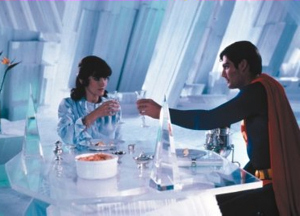
A Villain Must Redeem Himself

Everyone loves to see a good redemption story, so an easy way to engage the audience's emotions is with a villain who suddenly has a change of heart. We believe this method of storytelling was invented by the world of professional wrestling.
So we have Eve Teschmacher helping Superman in the first film, Mystique turning into a government informant in X-Men 3 and Dr. Octopus sacrificing his life in Spider-Man 2. But one film in particular has taken this rule to dizzying extremes: Spider-Man 3.
First, you've got Harry Osborn. In the first film, he's a pitiful character, ignored by his father and gradually losing his girlfriend. In part two, he's a drunk, a jerk and vengeful maniac. In the third installment, he gains redemption by riding to Spider-Man's rescue and sacrificing his life in the process.

But on top of all that you have Sandman, who goes through a similar series of steps, but solely within the third film. He gets pity banked in the beginning of the film through the manipulative use of a sick young daughter, does several dastardly deeds and then does an abrupt heel turn right at the end by apologizing to Spider-Man and sobbing like a little bitch. This seems to set off a chain reaction that has all of the characters in the film spending the last 10 minutes of screen time sobbing.
Also ...
There is about a 40 percent chance that the "redemption" will turn out to be part of the villain's hidden plan. You had Lex Luthor pretending to help Superman in Superman 2, then Magneto and Mystique temporarily helping the X-Men in part two before taking advantage of the situation for their own agenda. So that satisfies the audience's other emotional need, which is to believe that bad people are bad and we should never trust their attempts to be anything else.
The Fifth Film Reboots the Franchise

It's the rare franchise that makes it to four films at all, so maybe just making it there is a badge of honor. Or, maybe not. The problem is each film in a superhero franchise has to keep topping the one before it, and by the time you reach film number four, it's very hard to keep from straying into the ridiculous.
Therefore, by using Hollywood logic, if the previous film jumps the shark, the only way to repair the damage is by jumping the shark again, backwards, and continuing the series from a previous point, ignoring the movies that came in the middle.
For instance, Superman IV had the distinction of proving all the critics wrong who claimed that no superhero movie could be worse than Superman III.

It was bad enough that the studio shut down the Superman cash cow for almost two decades. So Superman Returns required a reboot for casting if nothing else, since Christopher Reeve suffered his horrible accident and eventually died, and Margot Kidder (Lois Lane) was certifiably insane, probably from the horrors of working on Superman IV. Also, actresses her age are generally not allowed to continue acting, so they replaced her with an actress young enough that, according to the film's timeline, she would have been a teenager when the original film took place.

Thus not a single actor from the original four movies appeared in the fifth, other than Marlon Brando, who was brought back from the dead specially for this film. The storyline presumably picks up sometime during the events from Superman II, specifically after Superman bonks Lois Lane (the rules and physics for alien-superhero intercourse will have to be covered in another article).
Of course Superman IV didn't hold the title of worst superhero movie ever made for very long, as the fourth Batman film (Batman and Robin) came along to take the title, with the film makers trying to cram in so many villains, costumes and sets, the whole thing became a nightmarish mess. Thus when it came time for the fifth film reboot, the decision was made to pretend the entire first four movies never, ever happened.
We guess what we're saying is if they make Blade IV next year, run far, far away from the theater. Then come back a few years later for the reboot.
Also ...
The fifth film reboot doesn't only apply to superhero movies, though maybe it should. The Rocky franchise got more and more inflated over the course of four films, culminating with Rocky, a legally retarded boxer, ending the Cold War. Stallone tried to do a "back to its gritty roots" reboot (twice) but the results were less than Batman Begins. And in case you thought there was no coming back from the fourth Karate Kid starring Hillary Swank, get ready for a Karate Kid reboot directed by Will Smith and starring his son Jaden. Seriously.
If the pattern holds, we should be due for gritty reboots of the Die Hard and Alien franchises any time now. Don't let us down, guys.
If you enjoyed that, check out our rundown of 5 Upcoming Comic Book Movies That Must Be Stopped. Also, be sure to find out about 15 cool things to do with your helicopter (featuring a few you might not have even tried yet). Or find out about 5 Douchebags Whose Mere Existence Should Make You Feel Cooler.